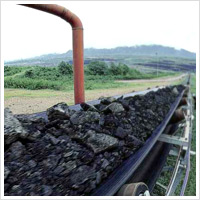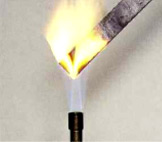- Home
- Products
- Diversified Products
- Conveyor Belt (English)
- Advanced Compounds
- Other Excellent Compound
Other Excellent Compounds
1. Flame Resistant Compound

When belts are used in places not easily accessible, it is important that fire risks are eliminated whenever possible.
Bridgestone offers flame-resistant belt depending on customer's operational conditions.
Flame Resistant Test (Example)
| Ignition | Removal | After 1min. | |
|---|---|---|---|
| Flame Resistant |  |
 |
 |
| Normal Belt |  |
 |
 |
2. Oil Resistant Compound
Oil contaminated materials cause ordinary rubber covers to swell and peel off. This swelling can cause a complete breakdown of the conveyor system as the swollen belt prevents it from passing over idlers and around pulleys. 3 types of oil resistant belts are available for transporting oil-drenched metal machining chips, oily sheet metal, foodstuff such as bulk beans and culls, and processed meats and fish.
| Type | Kind of oil | Temp | Oil adhering to belts |
|---|---|---|---|
| OIL ACE-H | Mineral Oil | -25°C60°C (-13F140F) |
Heavy oil, Barbolin, Rust preventive oil, Light oil, Neuter oil, Rolling oil, Grease, Machine oil, Drain sewage |
| OIL ACE-L | Animal & Vegetable Oil | Palm oil, Lard, Fish oil, Flay oil, Soy bean oil, Sesame oil, Cotton oil, Rice oil, Frying oil, Castor oil | |
| OIL ACE-G | Grain Oil | Corn oil, Soy bean oil, Uncrushed dried grain like barley |
*Note; Use oil resistant belt at normal temperatures. If it is overheated, the life of the belt will significantly decrease
Volume Change by Swelling


